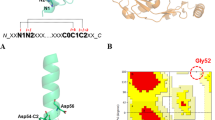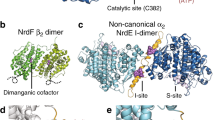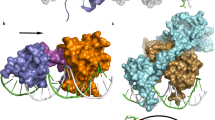Abstract
Comparative molecular modeling was performed with repressor protein Rro of the temperate Lactococcus lactis bacteriophage r1t using the known 3D-structures of related repressors in order to obtain thermolabile derivatives of Rro. Rro residues presumed to stabilize a nonhomologous but structurally conserved hydrophobic pocket, which was shown to be important for thermostability of the Escherichia coli bacteriophage lambda repressor Cl, were randomized. Of the derivatives that exhibited various temperature-sensitive phenotypes, one was shown to hold promise for both fundamental and industrial applications that require the controlled production of (heterologous) proteins in L. lactis.
This is a preview of subscription content, access via your institution
Access options
Subscribe to this journal
Receive 12 print issues and online access
$209.00 per year
only $17.42 per issue
Buy this article
- Purchase on Springer Link
- Instant access to full article PDF
Prices may be subject to local taxes which are calculated during checkout
Similar content being viewed by others
References
Kok, J. 1993. Genetics of proteolytic enzymes of lactococci and their role in cheese flavor development. J. Dairy. Sci. 76: 2056–2064.
Visser, S. 1993. Proteolytic enzymes and their relation to cheese ripening and flavor: an overview. J. Dairy. Sci. 76: 329–350.
Crow, V.L., Coolbear, T., Gopal, P.K., Martley, F.G., McKay, L.L., and Riepe, H. 1995. The role of autolysis of lactic acid bacteria in the ripening of cheese. Int. Dairy. J. 5: 855–875.
Fox, P.F., Wallace, J.M., Morgan, S., Lynch, C.M., Niland, E.J., and Tobin, J. 1996. Acceleration of cheese ripening. Antonie van Leeuwenhoek 70: 271–297.
Van Rooijen, R.J., Gasson, M.J. and de Vos, W.M. 1992. Characterization of the-promoter of the Lactococcus lactis lactose operon: contribution of flanking sequences and LacR repressor to its activity. J. Bacteriol. 174: 2273–2280.
de Ruyter, P.G.G.A., Kuipers, O.P., and de Vos, W.M. 1996. Controlled gene expression systems for Lactococcus lactiswith the food-grade inducer nisin. Appl. Environ. Microbiol. 62: 3662–3667.
O'Sullivan, D.J., Walker, S.A., West, S.G., and Klaenhammer, T.R. 1996. Development of an explosive expression strategy using a lytic phage to trigger explosive plasmid amplification and gene expression. Bio/Technology 14: 82–87.
Hendrix, R.W., Roberts, J.W., Stahl, F.W., and Weisberg, R.A. (eds.) 1983. Lambda II. Cold Spring Harbor Laboratory Press, Cold Spring Harbor, NY.
Rosenberg, M., Ho, Y.-S., and Shatzman, A.R. 1983. The use of pKC30 and its derivatives for controlled expression of genes. Methods Enzymol. 101: 123–138.
Shatzman, A.R., and Rosenberg, M. 1986. Efficient expression of heterologous genes in Escherichia coli: the pAS vector system and its applications. Ann. NX Acad. Sci. 478: 233–248.
Pabo, C.O., Sauer, R.T., Sturtevant, J.M., and Ptashne, M. 1979. The repressor contains two domains. Proc. Natl. Acad. Sci. USA 76: 1608–1612.
Little, R.J. 1993. LexA cleavage and other self-processing reactions. J. Bacteriol. 175: 4943–4950.
Pabo, C.O. and Sauer, R.T. 1992. Transcription factors: structural families and principles of DNA recognition. Annu. Rev. Biochem. 61: 1053–1095.
Pabo, C.O. and Lewis, M. 1982. The operator-binding domain of repressor: structure and DNA recognition. Nature 298: 443–447.
Nauta, A., van Sinderen, D., Karsens, H., Venema, G., and Kok, J. 1996. Inducible gene expression mediated by a repressor-operator system isolated from Lactococcus lactis bacteriophage rlt. Mol. Microbiol. 19: 1331–1341.
Beamer, L.J. and Pabo, C.O. 1992. Refined 1.8 Å crystal structure of the lambda repressor-operator complex. J. Mol. Biol. 227: 177–196.
Aggarwal, A.K., Rodgers, D.W., Drottar, M., Ptashne, M., and Harrison, S.C. 1988. Recognition of a DNA operator by the repressor of phage 434: A view at high resolution. Science 242: 899–907.
Lieb, M. 1981. A fine structure map of spontaneous and induced mutations in the lambda repressor gene, including insertions of IS elements. Mol. Gen. Genet. 184: 364–371.
Vriend, G. 1990. WHAT IF, a molecular modeling and drug design program. J. Mol. Graph. 8: 52–56.
Reidhaar-Olson, J.F. and Sauer, R.T. 1990. Functionally acceptable substitutions in two α-helical regions of λ repressor. Proteins 7: 306–316.
Hecht, M.H., Sturtevant, J.M., and Sauer, R.T. 1984. Effect of single amino acid replacements on the thermal stability of the NH2-terminal domain of phage λ repressor. Proc. Natl. Acad. Sci. USA 81: 5658–5689.
Varadarajan, R., Nagarajaram, H.A., and Ramakrishnan, C. 1996. A procedure for the prediction of temperature-sensitive mutants of a globular protein based solely on the amino acid sequence. Proc. Natl. Acad. Sci. USA 93: 13908–13913.
Casadaban, M.J. and Cohen, S.N. 1980. Analysis of gene control signals by DNA fusion and cloning in Escherichia coli. J. Mol. Biol. 138: 179–207.
Rottlander, E. and Trautner, T.A. 1970. Genetic and transfection studies with Bacillus subtilis phage SP50. J. Mol. Biol. 108: 47–60.
Leenhouts, K.J. and Venema, G. 1993. Lactococcal plasmid vectors, pp. 65–94 in Plasmids, A Practical Approach.Hardy, K.G. (ed.) Oxford University Press, Oxford, UK.
Terzaghi, B.E. and Sandine, W.E. 1975. Improved medium for lactic streptococci and their bacteriophages. Appl. Microbiol. 29: 807–813.
Birnboim, H.C. and Doly, J. 1979. A rapid alkaline extraction procedure for screening recombinant plasmid DNA. Nucleic Acids. Res. 7: 1513–1523.
Mandel, M. and Higa, A. 1970. Calcium-dependent bacteriophage DNA infection. J. Mol. Biol. 53: 159–162.
Rost, B. and Sander, C. 1993. Prediction of protein secondary structure at better than 70% accuracy. J. Mol. Biol. 232: 584–599.
Miller, J. 1972. Experiments in Molecular Genetics. Cold Spring Harbor Laboratory Press, Cold Spring Harbor, NY.
Laemmli, U.K. 1979. Cleavage of structural proteins during the assembly of the head of bacteriophage T4. Nature 227: 680–685.
Author information
Authors and Affiliations
Rights and permissions
About this article
Cite this article
Nauta, A., Burg, B., Karsens, H. et al. Design of thermolabile bacteriophage repressor mutants by comparative molecular modeling. Nat Biotechnol 15, 980–983 (1997). https://doi.org/10.1038/nbt1097-980
Received:
Accepted:
Issue Date:
DOI: https://doi.org/10.1038/nbt1097-980
This article is cited by
-
Production of recombinant proteins in E. coli by the heat inducible expression system based on the phage lambda pL and/or pR promoters
Microbial Cell Factories (2010)
-
Transcriptional analysis of the genetic elements involved in the lysogeny/lysis switch in the temperate lactococcal bacteriophage ϕLC3, and identification of the Cro-like protein ORF76
Molecular Genetics and Genomics (2003)



